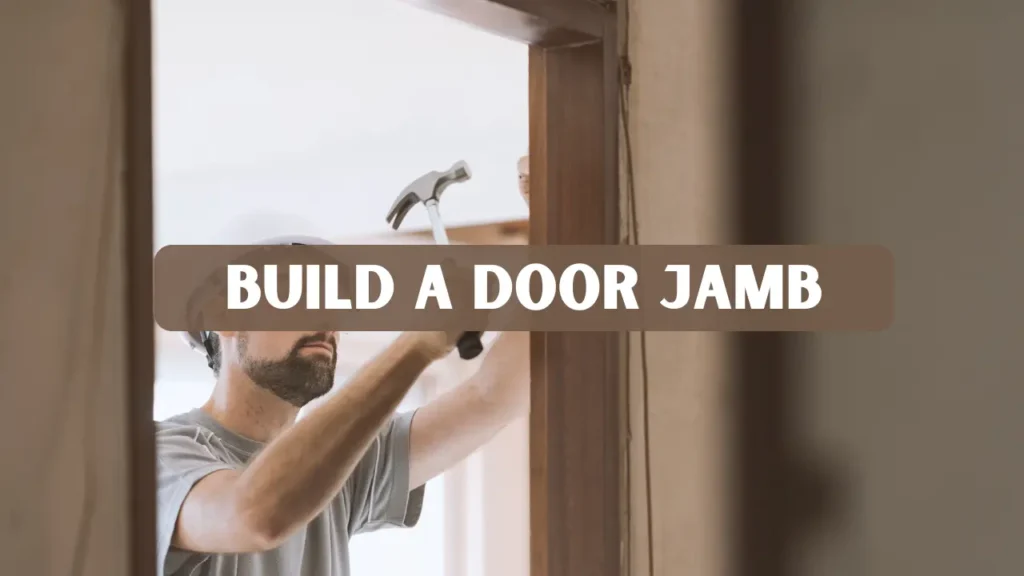Key Takeaways
- A properly built door jamb ensures smooth door operation and long-term durability.
- Accurate measurements, sturdy materials, and correct alignment are essential for success.
- This guide shows you how to build a door jamb like a professional carpenter using simple tools.
Why Build Your Own Door Jamb?
A door is only as good as the frame that supports it. Learning how to build a door jamb helps you create doors that open smoothly, close evenly, and last for years. The door jamb provides the structural foundation that holds the door, hinges, and latch in perfect alignment. Whether you’re installing a new interior door or restoring an older doorway, this guide offers complete, step-by-step instructions from material selection to final installation.
As a professional woodworker with over a decade of experience in fine joinery and furniture restoration, I’ve built and installed dozens of custom door jambs. This tutorial combines field-tested knowledge with proven carpentry techniques to help both beginners and experienced DIYers achieve excellent results.
Benefit of Building Door Jamb
When you build a door jamb yourself, you gain total control over its dimensions, materials, and appearance. Factory-made jambs often fail to match nonstandard wall thicknesses or unique wood finishes. A custom-built jamb, on the other hand, fits perfectly and blends with the surrounding décor.
Benefits:
- Custom Fit: Adjust to uneven walls and nonstandard openings.
- Stronger Construction: Use hardwoods like oak or maple for better stability.
- Cost-Effective: Building it yourself saves on labor and shipping.
- Aesthetic Freedom: Match stain color or molding style to your home’s interior.
A handcrafted jamb not only improves performance but also enhances the quality of your woodworking portfolio.
Materials and Tools You’ll Need
Materials
- Solid wood boards for jamb legs and head (1×4 or 1×6 recommended)
- Door stop molding (¼” to ⅜” thick)
- Screws (1¼” to 3″ length)
- Wood glue
- Wooden or plastic shims
- Sandpaper (80 to 220 grit)
- Wood filler
- Paint, stain, or varnish
- Finishing nails
Tools
- Measuring tape
- Carpenter’s square
- Circular saw or table saw
- Miter saw
- Router
- Chisels
- Drill and countersink bit
- Clamps
- Hammer or mallet
- Level
- Pencil and marking knife
- Safety gear (gloves, goggles, ear protection)
Proper tools ensure accuracy and safety throughout your woodworking process.
Planning and Measurements
Before cutting or assembling, precise measurements are critical. Incorrect dimensions can cause misalignment, uneven gaps, or door binding.
How to Measure the Opening
- Measure the rough opening width at the top, middle, and bottom. Record the smallest number.
- Measure the height on both sides of the opening and use the shorter measurement.
- Measure wall thickness, including drywall or plaster. This determines the jamb depth.
- If you already have the door, measure its width, height, and thickness.
Tip: Leave about ½ inch of total clearance around the door for shims and adjustment. Accurate measurement is the foundation of every successful build.
Door Jamb Profile and Material Choices
The wood you choose affects both appearance and durability. Hardwoods like oak, maple, or mahogany resist dents and last longer, while pine or poplar are easier to cut and ideal for painted finishes.
Jamb Types
- Square jamb: Simple design suitable for most interiors.
- Rabbeted jamb: Has a built-in stop that neatly seats the door edge.
- Applied stop jamb: The stop molding is added separately after assembly.
Choosing the right style ensures proper door seating and finish quality.
Step by Step Guide
Step 1: Cut the Jamb Pieces
Cut two vertical jamb legs equal to the door height plus 1½ inches. Cut the head piece to match the door width plus the desired gap for clearance. Use a table saw or circular saw to ensure clean, straight cuts. Mark the face sides to maintain grain consistency.
Step 2: Rout Hinge Mortises
Mark hinge locations accurately using the door as a template. Standard spacing places the top hinge 7 inches from the top, the bottom hinge 11 inches from the floor, and the middle hinge centered between them. Use a router or sharp chisel to create mortises about ⅛ inch deep. Test fit the hinge plates before proceeding.
Step 3: Assemble the Frame
Position the head piece between the jamb legs. Apply wood glue at the joints and clamp tightly. Drill pilot holes and secure with screws or nails. Check diagonals to confirm the frame is perfectly square. If measurements differ, make minor adjustments before the glue sets.
Step 4: Add the Door Stop
If you are using an applied stop, measure the thickness of the door plus clearance. Nail or glue the stop molding along the inside edges of the jamb. For a rabbeted jamb, the stop is part of the design, so no additional molding is needed. A uniform stop ensures smooth closure and prevents drafts.
Step 5: Sand, Prime, and Finish
Sand every surface with progressively finer grit until smooth. Apply wood filler to cover nail holes or imperfections. Use primer for painted finishes or stain and seal for natural wood. Allow adequate drying time between coats for a professional look.
Step 6: Install the Jamb
Set the jamb into the rough opening. Insert shims behind hinge locations and along the strike side to make it plumb and level. Drive 3-inch screws through the jamb into wall studs. Recheck alignment frequently. Once secure, cut excess shims flush with a utility knife. Finally, hang the door on its hinges to verify smooth swing and even spacing.
Real-World Example
During a heritage home restoration in Islamabad, I had to build a door jamb for an uneven masonry wall. The wall leaned slightly outward, creating a 6 mm difference from top to bottom. To fix this, I used cedar shims behind the strike side and carefully adjusted the hinge placement until the jamb aligned perfectly. Once installed, the door opened effortlessly and sealed tightly against the frame, proving how precise adjustment can correct long-standing structural flaws.
This hands-on experience reinforced how essential accuracy and patience are in woodworking. Even a modest project like constructing a custom jamb can improve your understanding of alignment, leveling, and fitting techniques. Experience like this shows that learning to build a jamb not only solves practical challenges but also develops skills useful in larger furniture and framing projects.
Common Mistakes and How to Avoid Them
- Skipping dry-fit testing: Always assemble pieces temporarily before gluing or screwing.
- Ignoring plumb and level: A crooked jamb leads to poor door function.
- Over-tightening screws: Can warp wood and pull jamb out of alignment.
- Using soft or wet lumber: This can shrink and cause gaps after drying.
- Failing to pre-drill: Prevents splitting and ensures clean fastener placement.
Every professional carpenter knows that time spent double-checking measurements saves hours of correction later.
Finishing Touches and Trim
After installation, add casing or molding around the jamb. Miter corners neatly at 45 degrees for a seamless look. Fill nail holes and apply caulk to joints before painting. These finishing details enhance both durability and aesthetics.
A neatly finished jamb improves the overall impression of the room and adds resale value to the home.
Troubleshooting
- Door doesn’t close properly: Check hinge depth or adjust shims on the hinge side.
- Gaps between jamb and wall: Fill with caulk or readjust shims.
- Creaking hinges: Lubricate with a light oil or tighten screws.
- Misaligned latch: Reposition strike plate slightly until it clicks perfectly.
Learning how to build a door jamb means understanding these small fixes that keep doors operating smoothly for years.
Estimated Cost
Typical cost for an interior wooden door jamb project:
- Pine boards: $20–$40
- Screws, glue, and shims: $10–$15
- Paint or finish: $15–$25
- Total: $45–$80 on average
For hardwood jambs, prices may rise depending on material and finish quality. Always choose wood that matches your door and home environment for the best results.
Conclusion
Mastering how to build a door jamb is a rewarding skill that improves your craftsmanship and adds value to every project. From precise measurements to careful sanding and installation, every step matters. Once you’ve built your first custom jamb, you’ll appreciate how much control and satisfaction comes from creating your own functional woodwork.
If you are a DIY enthusiast or woodworking hobbyist, take the time to measure accurately, use quality wood, and follow this guide step by step. You will end up with a professional-grade jamb that will last for decades.
FAQs
How thick should a door jamb be?
The jamb depth should match your wall thickness. Standard interior walls use 3½-inch jambs, while thicker walls may require custom sizing.
Can I reuse an existing jamb?
Yes, if it’s straight, undamaged, and square. However, warped or cracked jambs should be replaced.
What clearance is ideal between the door and jamb?
A clearance of about ⅛ inch ensures smooth swing without binding or gaps.
What screws should I use?
Use 3-inch wood screws to fasten jambs to framing studs. Place screws near hinge points for better load distribution.
Should I apply primer or stain first?
Always sand, then apply primer before painting. For stained finishes, apply stain first and seal afterward for protection.




